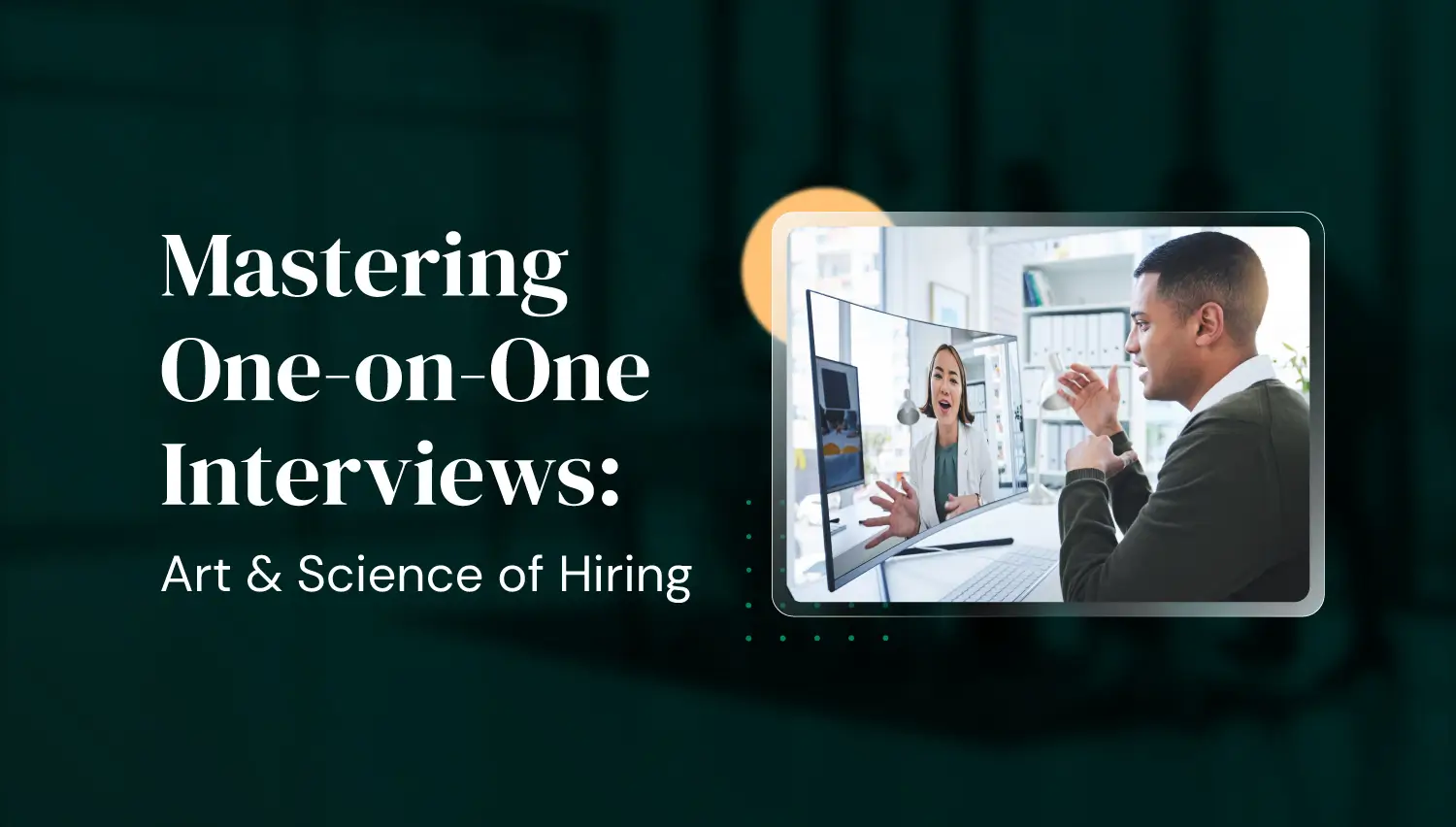Let me take you back a few years. I was interviewing this product manager for a SaaS company. On paper, he was golden: solid schools, solid jobs, solid achievements. But as we talked one-on-one, I started noticing cracks. He'd tense up whenever we touched on projects where he wasn't in charge, and he'd talk in these sweeping generalities about "driving results," but never got specific.
None of that stuff shows up on a resume or in a big panel interview, where conversations hover politely at thirty thousand feet. That day taught me just how powerful one-on-one interviews can be. They're where you glimpse the truth about how someone communicates, whether they play well with others, and how they handle questions that dig beneath the surface.
In the end, we passed on him. It wasn't an easy call, but it spared the team from hiring someone whose style clashed with the company's collaborative culture. That's the quiet magic of a one-on-one interview: it can change the entire course of a hiring decision for the better.
These days, one-on-ones are one of my go-to tools. They're the best way I know to get past shiny resumes and figure out if someone's the real deal.
What Are One-on-One Interviews, Really?
At its simplest, a one-on-one interview is just you and a candidate having a focused conversation. Compared to a panel (which can feel stiff or intimidating), this format feels more human. Candidates often open up and speak more freely.
The perks are big. You get a clearer sense of someone's personality, how they think, what motivates them. You can follow interesting threads in the conversation, dig deeper, and explore nuances that might stay hidden in a group setting. And for candidates, it usually feels less like being grilled under a spotlight and more like an actual conversation.
Of course, it's not perfect. One-on-ones take time. They demand interviewers who know how to avoid bias and stay structured. And they can veer into subjectivity if you're not careful.
Bottom line: knowing how and when to use one-on-ones is crucial if you want a hiring process that's thorough, fair, and a little more human.

How to Prepare for a One-on-One Interview
A good one-on-one interview doesn't start the moment the candidate walks in. It starts well before that. One of the biggest mistakes I've seen is managers treating these meetings like casual chats instead of structured evaluations. That's how you end up with inconsistent interviews, half-formed impressions, and major details slipping through the cracks.
Solid prep means knowing the role cold. Review the job description. Map out which skills and experiences are truly must-haves. Define what "good" looks like. Even in a one-on-one setting, consistency matters. I always bring a core list of questions tied to key competencies, while leaving room for the conversation to go where it needs to.
Another big piece: studying the candidate's resume. Look for gaps, frequent job changes, and standout achievements. A few pointed follow-ups can turn a generic interview into a revealing conversation.
And finally, know your goals before you walk into the room. What do you want to find out? What red flags or green lights are you listening for? Clarity up front keeps you focused and fair.
Running a Great One-on-One Interview
Even the best plan can flop if you don't execute well. Here's how to make your one-on-ones count.
Build Rapport, but Don't Let It Drift
Spend a few minutes easing into things. Ask about their industry experience or a project they're proud of. Keep it professional, and steer clear of topics that could get too personal or polarizing. Then pivot into business-focused questions so the chat doesn't meander too far.
For example, I like to start with, "So what first pulled you into [industry/company]?" It's friendly and also clues me in on their motivation.
Ask Questions That Go Somewhere
Generic stuff like "Are you good at problem-solving?" won't get you far. Instead, ask behavioral questions tied to real-world scenarios.
Try these:
- "Tell me about a time you disagreed with a colleague. How did you handle it?"
- "Describe a situation where you had to juggle competing deadlines."
- "Walk me through your decision-making process on a challenging project."
Behavioral questions prompt stories, and those stories often reveal more than any resume.
Listen Beyond the Words
Active listening is more than nodding along. Watch how candidates organize their thoughts, how they handle follow-up questions, and how they react to gentle pushback.
I pay attention to things like:
- Hesitation around discussing team dynamics
- Vague answers when specifics would be expected
- Body language shifts when certain topics come up
Sometimes what's not said is the real answer.
Don't Be Afraid to Dig Deeper
If someone's answer sounds surface-level, keep going. A simple "Can you tell me more about that?" can peel back the layers.
If a candidate claims they "led a successful product launch," I'll press with:
- "What specific parts did you personally lead?"
- "What obstacles popped up, and how did you handle them?"
- "If you could redo it, what would you change?"
Probing questions separate real experience from rehearsed sound bites.
Balance Skills and Culture Fit
Technical skills matter. But whether someone fits your team culture can make or break long-term success. One-on-ones are perfect for exploring this side.
I might ask:
- "What kind of team environment helps you do your best work?"
- "How do you like to receive feedback?"
- "Tell me about a time you had to adjust to a new way of working."
Their answers can reveal if they'll thrive (or clash) in your workplace.
After the Interview: Making It Count
A one-on-one interview's value comes down to what you do afterward. Without solid follow-up, even the best conversations dissolve into vague gut feelings.
Capture Your Thoughts While They're Fresh
Memories fade fast. Right after the interview, I jot down quick notes:
- Specific strengths and achievements
- Any concerns or red flags
- Interesting behaviors or body language
- Questions I wish I'd asked
Even five minutes of writing helps preserve details that might vanish by tomorrow.
And here's a pro tip: rely on structured interview forms. They help prompt your thinking and keep things consistent across candidates.
Don't Rely on "Gut Feel"
It's easy to mistake charm for competence. A confident candidate can leave a strong impression even if their answers are thin.
So I always check myself:
- "Did they back up their claims with examples?"
- "Were their stories deep or just surface-level?"
- "Am I reacting to personality rather than capability?"
If I can't cite evidence, I know I'm leaning too much on vibes.
Use a Scoring Rubric
Scoring candidates against a defined rubric keeps your decision-making grounded. Instead of just writing "Great communicator," I'll rate them on communication clarity, 1–5, and explain why.
Good rubrics often cover:
- Problem-solving ability
- Communication skills
- Leadership or influence
- Collaboration style
- Cultural alignment
Structured ratings make it way easier to compare people fairly.
Define What Culture Fit Really Means
"Culture fit" is too often code for "Do I like this person?" Instead, define it:
- Independent vs. collaborative work style
- Comfort with feedback and change
- Approach to conflict
Being explicit makes fit something you can evaluate rather than just feel.
Get Other Opinions
Even in a one-on-one process, I often debrief with colleagues, especially if I'm unsure. Sharing notes helps you see blind spots you might've missed.
It helps to frame it as, "Here's what I observed, does that match your experience with similar candidates?"
Communicate Quickly and Respectfully
Nobody likes being ghosted. Whether you're moving forward or passing, communicate promptly. It shows respect for the candidate's time and protects your company's reputation.
A short follow-up might include:
- Thanks for their time
- Honest but tactful feedback
- Clear next steps or closure
Silence leaves a bad taste. Even a polite "no" is better than nothing.
Creating a Great Candidate Experience
One-on-one interviews don't just help you choose the right hire; they also shape how people feel about your company. Even the folks you don't hire will talk about you. So make it count.
Be Transparent from the Start
Candidates get rattled by uncertainty. Before the interview, send them:
- Who they'll meet
- How long it will take
- Whether it's remote or in-person
- Topics you'll cover
Transparency lowers anxiety and helps candidates show up at their best.
Make It Comfortable
Small gestures go a long way. Offer water. Check your tech setup if it's remote. Minimize interruptions. Candidates should feel you're present and respectful of their time.
For remote calls, log on a few minutes early to make sure Zoom doesn't crash on you.
Let Them Talk
Don't turn the interview into a lecture. Give candidates space to tell their stories. Avoid cutting them off, and show genuine interest.
A candidate once told me the best interview she'd ever had felt like a real conversation, not a one-sided grilling. That's the bar I try to hit.
Be Honest, but Kind
Candidates want the truth about challenges in the role, company changes, or team dynamics. Sugarcoating might help you close a hire, but it leads to disappointment later.
That said, there's a difference between candor and cruelty. Talk about challenges constructively, not critically.
Keep People in the Loop
Silence is loud. Even if your process drags on, keep candidates updated so they're not left guessing.
When delivering rejections, a quick email explaining that you've gone with someone whose background fits closer is better than radio silence. Whenever possible, offer brief, constructive feedback – it's rare, and candidates appreciate it.
Remember: Every Candidate Is an Ambassador
Not every candidate will join your team. But any one of them might:
- Be a fit for another role later
- Send you great referrals
- Speak highly of your brand (or not)
A good candidate experience builds goodwill that can pay off in ways you might not expect.

Weaving One-on-One Interviews into a Broader Strategy
One-on-ones are powerful, but they're not the whole picture. The smartest hiring processes combine them with other tools to paint a fuller view of candidates' skills, potential, and fit.
Pair Interviews with Other Assessments
Interviews alone can't reveal everything. Even the best interviewer can be swayed by charm or, on the opposite end, nerves.
Consider pairing one-on-ones with:
- Work samples or simulations – See how someone handles real tasks.
- Technical assessments – For technical roles, coding challenges or problem-solving exercises give you objective data.
- Personality or work-style tests – Not definitive, but helpful for spotting communication styles or team dynamics.
Combined with interview insights, these tools give you a more complete picture.
Train Interviewers to Avoid Bias
Everyone has biases, even the most seasoned interviewer. One-on-one settings can make this worse, since there's no second set of eyes in the room.
Training helps interviewers:
- Recognize common biases
- Stick to structured questions
- Focus on evidence, not gut feeling
I've seen hiring quality improve dramatically just by teaching managers how to listen more objectively and probe deeper.
Keep Things Consistent
Without consistency, two candidates for the same role could have wildly different experiences and get judged on totally different criteria.
A solid process means:
- Standardizing core questions tied to competencies
- Using the same scoring rubrics for everyone
- Debriefing systematically with hiring teams
This isn't about turning interviews into robotic interactions. It's about making things fair and keeping charisma from overshadowing competence.
Use Tech, but Keep It Human
Modern recruiting tech can make life easier:
- Scheduling tools cut back-and-forth emails.
- Video recordings (with consent) let you review key moments.
- AI note-takers help you focus on the conversation instead of scribbling notes.
But remember: tech is a tool, not a replacement for human judgment. Use it to improve consistency and efficiency, but don't let it make your process feel robotic.
Don't Lose Sight of the Candidate
Building a holistic process shouldn't make hiring feel cold or transactional. Balance structure with humanity. Make sure candidates feel respected, heard, and valued, no matter the outcome.
Ready to Take Your Hiring Global?
One-on-one interviews are one of the sharpest tools in your hiring kit. When done well, they help you look past resumes and discover who someone really is, and whether they'll thrive on your team. But like every part of hiring, they work best as part of a thoughtful, structured strategy, especially when your talent search stretches across borders.
If you're aiming to level up your interviews or expand your hiring globally, remember: you don't have to go it alone. At Somewhere, we help companies tap into global talent and build world-class teams. Whether you're navigating remote hiring or looking for candidates who truly fit your culture, we partner with you to solve complex recruiting challenges and help you scale your hiring with confidence.
If you're ready to refine your interviews or expand your hiring worldwide, reach out to Somewhere. Fill out the form below, and let's talk about making your next hire your best one yet.








.jpeg)

.jpeg)



